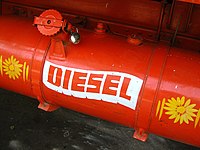
Photo from wikipedia
Abstract A thermodynamic analysis based on the minimization of the Gibbs free energy method was performed in order to study the steam reforming of real bio-oils (obtained from biomass fast… Click to show full abstract
Abstract A thermodynamic analysis based on the minimization of the Gibbs free energy method was performed in order to study the steam reforming of real bio-oils (obtained from biomass fast pyrolysis) from different sources. For comparison purposes, four types of reactors were used, namely: traditional reactor (TR), membrane reactor (MR) with H2 separation, sorption-enhanced reactor (SER) with CO2 sorption, and sorption-enhanced membrane reactor (SEMR) with both H2 and CO2 separation. The CO2 capture was studied varying the sorbent (CaO) to feed molar ratio (SFR) while the effect of the H2 removal was assessed with the use of a removal fraction (fH2) of 0 to 0.8 (typical recoveries for an H2-selective membrane). The simulated results obtained for the TR showed a good agreement with those reported in literature experimental works at similar operation conditions. The optimum conditions for the production of hydrogen were obtained in the SEMR in which it was possible to obtain 99% of the maximum theoretical yield for spruce bio-oil and 97% of the maximum yield for wheat bio-oil. Furthermore, this reactor configuration minimizes CH4, H2, CO, CO2 and coke yields. In addition, the effect of pressure in a range of 1 to 10 bar was also assessed for the reactor configurations with H2 removal. It was shown that the increase of pressure decreases H2 yield; nevertheless, this can be offset by moderately increasing the WFR.
Journal Title: Fuel
Year Published: 2019
Link to full text (if available)
Share on Social Media: Sign Up to like & get
recommendations!